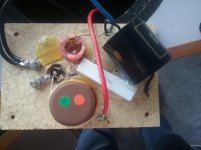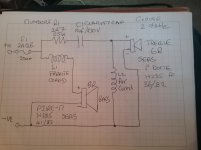Hi. I'm trying to find datasheet for the SEAS drivers in my Mark 1 Mission 770s. The drivers are: Tweeter - H235 FF 1" dome. Bass - PR21RE-M H285 8" Polypropylene. I've had no luck so far. Can anyone help? Thanks in antipation.
I think those were made on order by Mission and not available for resale. Why do you need the data sheets?
Looking to work out values of inductors on the crossover. I know the resistor and cap value as I've updated those. I know the impedance of the drivers but not at the crossover frequency of 2.7KHz.
It's fairly easy to obtain the impedance at a single frequency:
1) Apply a known voltage (mag & phase) at required freq (2.7k) from an amplifier.
2) Measure the current magnitude and phase.
3) Calculate the impedance from the above.
It would be easier to help if you disclose what exactly it is that you're trying to achieve by measuring the inductors in the network. Are you looking to change their values ? If so, there may be easier methods to get what you want.
Pls Note: Your handle reminds me of Michael Schumacher.
1) Apply a known voltage (mag & phase) at required freq (2.7k) from an amplifier.
2) Measure the current magnitude and phase.
3) Calculate the impedance from the above.
It would be easier to help if you disclose what exactly it is that you're trying to achieve by measuring the inductors in the network. Are you looking to change their values ? If so, there may be easier methods to get what you want.
Pls Note: Your handle reminds me of Michael Schumacher.
I was a big fan of MS
Not looking to change value, just want to know what they are so I can update them at some point. Other bit I'm not sure about is why the coil in the bass feed is ferrite cored and in the treble, air cored?
Not looking to change value, just want to know what they are so I can update them at some point. Other bit I'm not sure about is why the coil in the bass feed is ferrite cored and in the treble, air cored?
I wouldn't sweat the exact tweeter in your position.
TWEETERS
SEAS haven't changed the basic design much in years. 😀
Measure the base plate. If it is 104mm, you could use almost any of the current 27 series. All around 90dB loudness and 4.8 ohms DC.
Ferrite bass coils are common enough. In theory an air-core might sound better but cost more. Air-cores are used in tweeter circuits by most manufacturers because they are cheap. But will you hear the difference?
TWEETERS
SEAS haven't changed the basic design much in years. 😀
Measure the base plate. If it is 104mm, you could use almost any of the current 27 series. All around 90dB loudness and 4.8 ohms DC.
Ferrite bass coils are common enough. In theory an air-core might sound better but cost more. Air-cores are used in tweeter circuits by most manufacturers because they are cheap. But will you hear the difference?
I was a big fan of MS
Not looking to change value, just want to know what they are so I can update them at some point. Other bit I'm not sure about is why the coil in the bass feed is ferrite cored and in the treble, air cored?
The ferrite core has higher relative permeability (read 1000x), which reduces the number of turns (and thus coil resistance) for the required inductance when compared to air-core ones, with the downside being that they also tend to have a hysteresis curve (non-linearity) to deal with. You may measure the inductance as follows:
1) Perform a sine-wave sweep (using an amplifier) into an LR circuit formed by the said inductor and a known resistor value.
2) Find out the cutoff frequency of the LR network using a multimeter.
3) Work out the inductance, using f = 1/2pi (R/L).
And, please write "I am a big fan of MS".
Last edited:
Cheers Steve. I updated the resistor and cap a couple of years ago. From basic to Mundorf wire wound in ceramic 2R7 25W and Clarity Cap 10uf. I was just thinking of updating the coils but can't get to the required values. I've attached a pic and the circuit diagram I've drawn out whilst I was replacing a broken fuse holder. I also was wo dering if the coils should not be in the same orientation but at 90° to each other?
Attachments
Sorry, yes Am a big fan of MS and looking forward to how his son gets on this year. I haven't got a signal generator to perform a sweep I'm sorry.
Well, if you can play sinusoidal tones from your computer through an amplifier, then maybe you don't need your signal generator? Just a thought.
Online signal generator: Online Tone Generator - Free, Simple and Easy to Use.
The magnitude is not important, you only need your cutoff frequency. Just be careful to not clip the amplifier. Use multimeter in AC rms mode.
Online signal generator: Online Tone Generator - Free, Simple and Easy to Use.
The magnitude is not important, you only need your cutoff frequency. Just be careful to not clip the amplifier. Use multimeter in AC rms mode.
Last edited:
Not looking to change value, just want to know what they are so I can update them at some point. Other bit I'm not sure about is why the coil in the bass feed is ferrite cored and in the treble, air cored?
I fail to see how you can update a coil. A coil won't deteriorate over time so there is no need to change it. The only problem that a cored coil can exhibit is the saturation, but this problem is grossly overemphasized because any sensible mfg will use a cored coil that won't saturate in normal conditions.
The reason that Mission used an air core coil for the treble and a cored one for the bass is:
a 0.x mH air core coil used for the treble is inexpensive and cost equal or less than a cored coil with the same inductance,
the bigger coil used for the bass (>1mH), has a way lower DCR if cored vs air at constant AWG. To match the DCR the wire diameter for the air core coil should be bigger, and the coil will cost more without sensible performance difference. Just as an example, a 2.2mH coil with a 1mm wire, has a DCR of 0.8 Ohm if air core, and 0.34 Ohm if cored, and only an air core coil with a 1.8 mm wire can match the 0.34 Ohm DCR, with more than 1 Kg of copper...
If you want to replace the cored coil, you need to match inductance and DCR. The only way to know those values is with a measure, a datasheet won't tell you nothing. The easiest way is with a multimeter, even a cheap one will do the trick, but IMHO changing the coils is useless.
Ralf
Besides, even if it does saturate and exhibit any retentivity, I think it should be possible to reset the offset flux (de-gauss) using an external circuit of some kind, a 0A current source, I think. Yes, chokes are almost immortal. In fact, magnetic components in general exhibit much higher reliability when compared to semiconductors or other passive components.
Last edited:
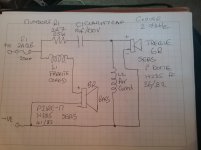
I wouldn't sweat the exact tweeter in your position.
TWEETERS
SEAS haven't changed the basic design much in years. 😀
Measure the base plate. If it is 104mm, you could use almost any of the current 27 series. All around 90dB loudness and 4.8 ohms DC.
Ferrite bass coils are common enough. In theory an air-core might sound better but cost more. Air-cores are used in tweeter circuits by most manufacturers because they are cheap. But will you hear the difference?
Hi Steve. I've been reading another thread that you commented on a lot in relation to the crossovers of 770 in response to Slipmyster from 2014 onwards. I think I understood in 1 post that you thought there was a better crossover design to use. I know Slipmyster changed the tweeters. I have retained the original SEAS drivers. The circuit is currently as attached.
Last edited:
Your speaker is quite familiar on crossover.
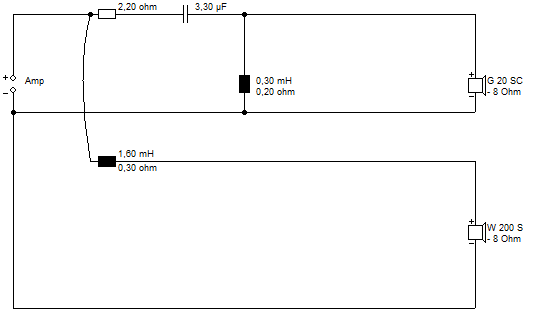
Above is my Monitor Audio R300-MD.
Restoring Monitor Audio R300 bookshelf speakers.
I have had much fun twiddling the crossover. An interesting idea is to take the ferrofluid out of the tweeter. I think it sounds better without. You can buy ferrofluid easily enough if needed.
Sonics by Joachim Gerhard cabinets and kits.
Above is my Monitor Audio R300-MD.
Restoring Monitor Audio R300 bookshelf speakers.
I have had much fun twiddling the crossover. An interesting idea is to take the ferrofluid out of the tweeter. I think it sounds better without. You can buy ferrofluid easily enough if needed.
Sonics by Joachim Gerhard cabinets and kits.
I'm not suggesting any particular values. It's a simple speaker and there are lots of ways to do things. The old SEAS Njord kit:
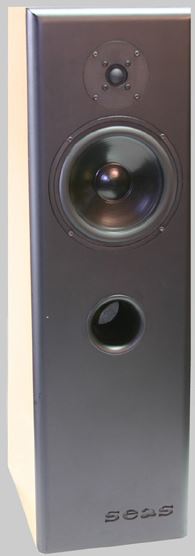
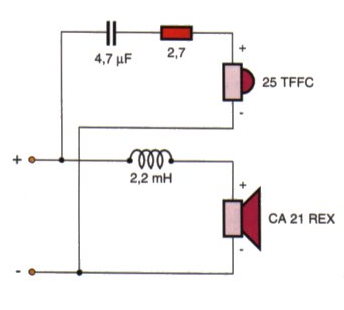
I tend to higher order filters these days. A cleaner sound IMO.
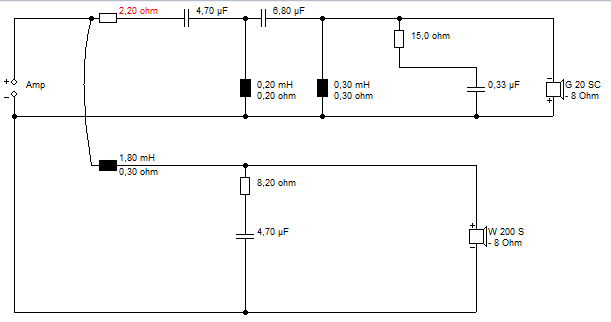
It's the hobby.
I tend to higher order filters these days. A cleaner sound IMO.
It's the hobby.
Last edited:
So how would I go about designing/building an appropriate higher order xover for the volume of box and drivers in the 770?
You download Visaton Boxsim and learn to use it:
Software | Visaton
I winged it a bit and used the W200S-8 bass and G20SC tweeter for my 19TAF/G. The SC10N tweeter is quite SEAS 27, as it goes. Nice software to use.
Software | Visaton
I winged it a bit and used the W200S-8 bass and G20SC tweeter for my 19TAF/G. The SC10N tweeter is quite SEAS 27, as it goes. Nice software to use.
- Home
- Loudspeakers
- Multi-Way
- SEAS driver datasheets
